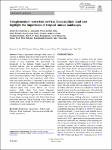Item Infomation
Full metadata record
| DC Field | Value | Language |
|---|---|---|
| dc.contributor.author | Raveloaritiana, Estelle | - |
| dc.contributor.author | Wurz, Annemarie | - |
| dc.contributor.author | Osen, Kristina | - |
| dc.date.accessioned | 2023-10-03T03:30:19Z | - |
| dc.date.available | 2023-10-03T03:30:19Z | - |
| dc.date.issued | 2023 | - |
| dc.identifier.uri | https://link.springer.com/article/10.1007/s13280-023-01888-3 | - |
| dc.identifier.uri | https://dlib.phenikaa-uni.edu.vn/handle/PNK/9414 | - |
| dc.description | CC-BY | vi |
| dc.description.abstract | Tropical agricultural landscapes often consist of a mosaic of different land uses, yet little is known about the spectrum of ecosystem service bundles and materials they provide to rural households. We interviewed 320 households on the different benefits received from prevalent land-use types in north-eastern Madagascar (old-growth forests, forest fragments, vanilla agroforests, woody fallows, herbaceous fallows, and rice paddies) in terms of ecosystem services and plant uses. Old-growth forests and forest fragments were reported as important for regulating services (e.g. water regulation), whilst fallow lands and vanilla agroforests as important for provisioning services (food, medicine, fodder). | vi |
| dc.language.iso | en | vi |
| dc.publisher | Springer | vi |
| dc.subject | Complementary ecosystem | vi |
| dc.subject | tropical mosaic landscapes | vi |
| dc.title | Complementary ecosystem services from multiple land uses highlight the importance of tropical mosaic landscapes | vi |
| dc.type | Book | vi |
| Appears in Collections | ||
| OER - Khoa học môi trường | ||
Files in This Item:

